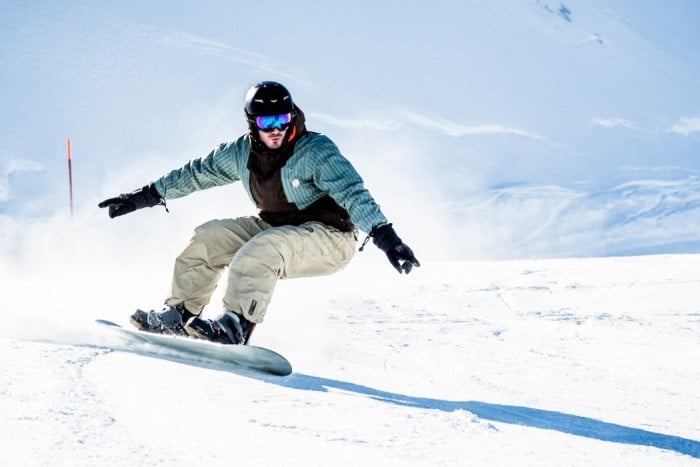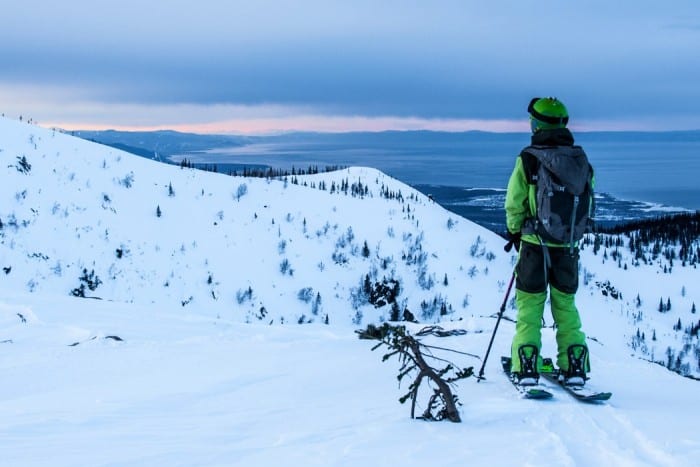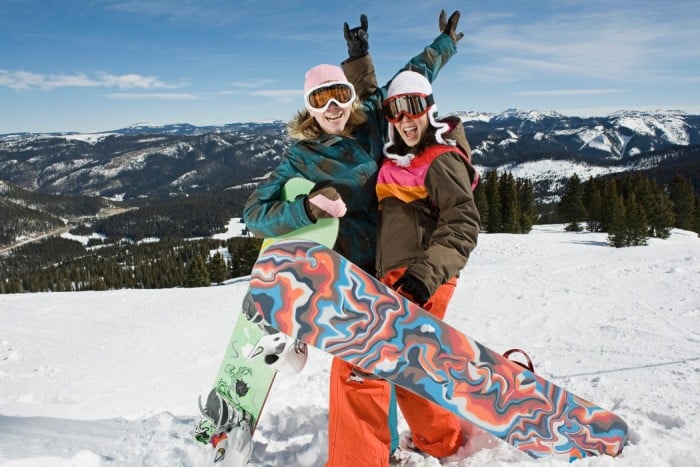Snowboarding may seem pretty straightforward to the outsider, but the sport is far from simple. Most people are surprised at its complexity and the number of different styles that exist.
Snowboarding is an exhilarating winter sport that involves using a specialized board and boots to descend a mountain, with the rider sometimes performing tricks or stunts. While extremely fun and freeing, snowboarding can be hard work, takes a lot of perseverance and practice, and can be dangerous without proper precautions and training.
So how would we describe snowboarding and its different disciplines, and what words do snowboarders themselves use to describe their favorite pastime?
Snowboarding And Its Types
Snowboarding is a winter sport that takes place on a snow-covered slope (or occasionally a “dry” practice slope). The rider wears specialized snowboard boots secured to the board with a pair of bindings.
Snowboarders then use their feet and body weight to engage the edges of the board with the snow, using this friction to control their speed and make turns.
However, while snowboarding principles are constant, riders can choose from plenty of different types and styles of snowboarding.

Types Of Snowboarding
One of the things that makes snowboarding unique is the vast number of disciplines that exist.
Some of these have now become Olympic events, whereas others exist purely for enjoyment, and while some riders stick with one style of snowboarding, others prefer to mix things up and try a bit of everything.
Let’s take a look at some of the different styles of snowboarding.
1. Freestyle
Freestyle snowboarding is all about tricks, stunts, and big air.
Most freestyle snowboarding happens in a park (also known as a terrain park), a purpose-built area within a ski resort that features a range of kickers, jumps, rails, and boxes.
Some parks have small halfpipe sections, whereas others may feature superpipes: massive halfpipes that have become an event in their own right in the world of global snowboard competitions.
Aside from air tricks like rotations, flips, and grabs, we have what’s known as jibbing, which is tricking using objects.
While most parks include features for jibbing, some snowboarders mimic skateboarders by “urban jibbing,” taking their boards to snow-covered streets and stairways and using everyday objects to perform their tricks.
Lastly, we have “butter” tricks, which get their name from the idea that pressing the nose or tail of a snowboard into the snow looks like using a knife to butter bread.
These are tricks that are executed on very small inclines or flat sections of snow, usually to break up the monotony of slow sections of the ski run.
2. Freeriding
Freeriding takes place away from the terrain parks and the groomed pistes, with riders taking to the natural backcountry of the mountain.
Freeriders seek out the deepest powder and fresh lines, with far fewer limitations than those imposed by marked runs.
Freeriders take advantage of a range of terrain, including gentle inclines, dense forest runs, or some of the world’s biggest and most remote peaks, sometimes even using helicopters to reach their starting position.
Freeriding provides a sense of adventure and allows the rider a level of creativity when it comes to choosing their path down the mountain.
This style often contains elements of freestyle snowboarding, with riders using natural features for their stunts.
It’s worth noting that freeriding comes with a number of risks, such as avalanches and being further away from help in the case of an emergency.
3. Splitboarding
Splitboarding is effectively freeriding but with one major difference. Splitboards are uniquely designed snowboards that can be split into two sections and used as cross-country skis.
Once the two sides of the board have been separated, the rider slips them into skins that provide extra friction on the snow and can use them with ski poles to traverse flat sections of the mountain or even make short climbs.
When they’ve reached their desired destination, the skins come off, the poles go away, the board gets clipped back together, and the freeriding begins.

4. All-Mountain
All-mountain snowboarding is an all-encompassing term that refers to a type of riding that combines the styles above (minus splitboarding).
These riders divide their time between the snow park, the groomed runs, and the backcountry, and it’s the most common type of snowboarding.
Most snowboarders pick all-mountain snowboards because they’re the most versatile.
5. Racing
The most common types of snowboard racing are slalom and boardercross. Slalom racing involves the rider racing down a slope while weaving in and out of marked gates.
It’s sometimes run as a time trial race, whereas parallel slalom racing pits two snowboarders against each other, side by side.
These racers usually ride longer, specialized racing boards, and their snowboard boots will be similar to ski boots.
Boardercross was inspired by motocross racing, hence the name, and involves four to six riders competing simultaneously down a purpose-built track.
This track features berms, jumps, and other obstacles to challenge the racers.
How Do Snowboarders Describe Snowboarding?
So we’ve described what snowboarding is and covered the definitions of the different snowboarding styles, but how do you actually describe snowboarding?
We asked around, and these were the most common descriptors that snowboarders gave us.
1. “Exhilarating”
Snowboarding is a high-adrenaline sport, whether you’re racing down the mountain at break-neck speeds or hoping you land a massive jump.
There’s a level of controlled risk that means there’s always a small amount of danger at the back of your mind, but the thrill of speeding down the mountain is addictive.

2. “Exhausting”
Everyone agrees that snowboarding is a workout, and it helps to be in decent shape. Beginners get tired from constantly falling down and picking themselves back up.
Freeriders have to hike through deep snow at times to find the best lines, and a fall in deep powder may not hurt but can take a ton of effort to get back up from.
You’re also constantly engaging your core and putting your lower body through its paces – you’ll rarely get a better night’s sleep than after a day of snowboarding.
3. “Challenging”
It’s a common saying that snowboarding is the opposite of skiing in the sense that it’s harder to learn but easier to master, and anyone who’s tried both will tend to agree.
The learning curve for snowboarding is steep and usually comes with a few bruises.
Even if you’re a seasoned snowboarder, everyone has their off-days or their confidence takes a knock after a crash, and you need a lot of perseverance to dust yourself off and keep going.
However, the challenge and progression in the sport are a big part of the fun.
4. “Freeing”
Just being out in nature gives most people a tremendous sense of freedom.
Away from your job, away from the hustle and bustle of the city, away from your everyday stresses and responsibilities, snowboarding is freeing.
There’s no other way to describe the feeling when you leave the busy pistes and head into the backcountry, where you can ride wherever you like with the sole purpose of enjoying yourself.
5. “Peaceful”
Once you’ve conquered the stressful learning stage of snowboarding, the sport becomes almost meditative.
You feel one with nature, and as you cruise down the slope, muscle memory takes over, so you’re only thinking about where you’re headed.
It’s just you, your board, your tunes, and the mountain. Some folks do yoga to feel zen, others snowboard.
Conclusion
While the specifics are a little more complicated, it’s pretty easy to describe snowboarding in a basic sense – what gear you need, how it works, and the different styles.
However, when you ask snowboarders how they describe their passion, you might get a different answer every time.
Despite the risks and challenges, most riders will agree that it’s highly addictive, and no matter what kind of day they’ve had on the board, they can’t stop thinking about their next run.
